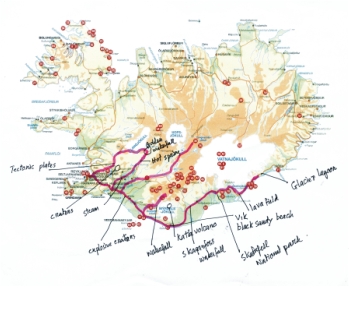visiting another planet on earth
Scientists involved in Martian missions often try out their gadgets in places with extreme atmospheric conditions in the cold north. There are places on earth where normal life forms do not exist and humans cannot live without their particular equipment and appropriate clothes. Iceland is just one of those places that replicates Martian landscapes and conditions to a large extent.
Life in Iceland is extremely difficult to say the least. Other than the harsh cold, the livelihood of the small population there is subject to earthquakes, volcanic eruptions, unique natural phenomenons, primitive landscapes, almost no trees and minimal diversity of life forms.
It is thus hardly surprising that Iceland attracts very few visitors. The number of tourists from Bangladesh is even lower. Cardiologist Dr. Mahboob Ali is one of the very few Bangladeshis to have visited this strange land. Being a photography enthusiast for decades, he brought back hundreds of photographs to share with us.
Every year, Ali attempts to visit unusual places and records his experiences in his films. This year, Ali along with his wife and son first planned to visit Siberia, but then decided to go to Iceland from Paris by Iceland Air.
A trip on the Iceland Air is not a cheap affair, costing around US 1000 dollars per head for a round trip from Paris.
“We flew from France to Reykjavik on May 22. There are only a few airliners following that route, one of them being British Airways,” he said. Because of the cost factor, his Iceland venture was just four days long.
 This map shows Dr. Ali's stopovers to different sites across the southern Iceland This map shows Dr. Ali's stopovers to different sites across the southern Iceland |
They lodged in a hotel in Iceland's capital Reykjavik for 400 Euro per day. "Other than hotels, tourists can stay as live-in guests with local families," he said.
Ali hired a "super jeep" for about 800 Euro daily which was equipped to drive through the tough terrain and resist the bitter cold weather and strong wind.
"Everyday we traveled between 10 to 12 hours to see the natural wonders of Iceland. We used to leave our hotel at 10 am and return at around 11 pm," Ali said.
As only 0.07 percent of Iceland’s land is arable, it is not difficult to understand why Iceland severely lacks in trees. Although vegetation was a rare sight during the family’s trips through the wilderness, their views were captivated by mammoth glaciers and an alien landscape of rock and ice. "It is like nothing we have seen anywhere," Ali says.
About Iceland:
Attracting Scottish and Irish immigrants during the late 9th and 10th centuries, Iceland boasts the world's oldest functioning legislative assembly, the Althing, which was established in 930. Although Iceland had been ruled by Norway and Denmark during the earlier periods of the country’s history, it has been independent for more than 300 years now.
In 1875, fallout from the Askja volcano devastated the Icelandic economy and caused widespread famine. Over the next quarter of the century, 20 percent of the island's population emigrated, mostly to Canada and USA. Limited home rule from Denmark was granted in 1874 and complete independence attained in 1944. Literacy, longevity, income, and social cohesion are first-rate by world standards.
With a total land area of 103,000 sq km, Iceland has a small population base of 299,388.
Its capital Reykjavik is the northernmost national capital in the world enjoying a strategic location between Greenland and Europe. It has more land covered by glaciers than in all of continental Europe together.
Iceland's Scandinavian-style economy is esentially capitalistic, although it boasts an extensive welfare system including generous housing subsidies, low unemployment, and a remarkably even distribution of income. In the absence of other natural resources (exclusive of abundant geothermal power), the economy depends heavily on the fishing industry, which provides 70 percent of export earnings and employs 4 percent of the labour force. The economy remains sensitive to declining fish stocks as well as to fluctuations in world prices for its main exports: fish and fish products, aluminium, and ferro-silicon. Government policies include reducing the current account deficit, limiting foreign borrowing, controlling inflation, revising agricultural and fishing policies, and diversifying the economy. The government remains opposed to EU membership, primarily because of Icelanders' concern about losing control over their fishing resources. Iceland's economy has been diversifying into manufacturing and service industries during the last decade, and new developments in software production, biotechnology, and financial services are taking place. The tourism sector is also expanding, with the recent trends in eco-tourism and whale watching. Growth had been remarkably steady between 1996-2001 at 3-5 percent, but could not be sustained in 2002 due an environment of global recession.
By Sharier Khan
Photo: Dr. Mahboob Ali

